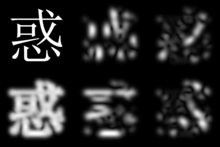Gabor filter
来源:互联网 发布:手机淘宝个人主页标签 编辑:程序博客网 时间:2024/06/04 18:31
Gabor filter
In image processing, a Gabor filter, named after Dennis Gabor, is a linear filter used for edge detection. Frequency and orientation representations of Gabor filters are similar to those of the human visual system, and they have been found to be particularly appropriate for texture representation and discrimination. In the spatial domain, a 2D Gabor filter is a Gaussian kernel function modulated by a sinusoidal plane wave.
J. G. Daugman discovered that simple cells in the visual cortex of mammalian brains can be modeled by Gabor functions.[1] Thus, image analysis by the Gabor functions is similar to perception in the human visual system.
Contents
[hide]- 1 Definition
- 2 Feature extraction
- 3 Wavelet space
- 4 Example implementation
- 5 See also
- 6 References
- 7 External links
- 8 Further reading
Definition[edit]
Its impulse response is defined by a sinusoidal wave (a plane wave for 2D Gabor filters) multiplied by a Gaussian function.[2] Because of the multiplication-convolution property (Convolution theorem), the Fourier transform of a Gabor filter's impulse response is the convolution of the Fourier transform of the harmonic function and the Fourier transform of the Gaussian function. The filter has a real and an imaginary component representing orthogonal directions.[3] The two components may be formed into acomplex number or used individually.
Complex
Real
Imaginary
where
and
In this equation,  represents the wavelength of the sinusoidal factor,
represents the wavelength of the sinusoidal factor,  represents the orientation of the normal to the parallel stripes of a Gabor function,
represents the orientation of the normal to the parallel stripes of a Gabor function,  is the phase offset,
is the phase offset,  is the sigma/standard deviation of the Gaussian envelope and
is the sigma/standard deviation of the Gaussian envelope and  is the spatial aspect ratio, and specifies the ellipticity of the support of the Gabor function.
is the spatial aspect ratio, and specifies the ellipticity of the support of the Gabor function.
Feature extraction[edit]
A set of Gabor filters with different frequencies and orientations may be helpful for extracting useful features from an image.
Wavelet space[edit]
Gabor filters are directly related to Gabor wavelets, since they can be designed for a number of dilations and rotations. However, in general, expansion is not applied for Gabor wavelets, since this requires computation of bi-orthogonal wavelets, which may be very time-consuming. Therefore, usually, a filter bank consisting of Gabor filters with various scales and rotations is created. The filters are convolved with the signal, resulting in a so-called Gabor space. This process is closely related to processes in the primary visual cortex.[4] Jones and Palmer showed that the real part of the complex Gabor function is a good fit to the receptive field weight functions found in simple cells in a cat's striate cortex.[5]
The Gabor space is very useful in image processing applications such as optical character recognition, iris recognition and fingerprint recognition. Relations between activations for a specific spatial location are very distinctive between objects in an image. Furthermore, important activations can be extracted from the Gabor space in order to create a sparse object representation.
Example implementation[edit]
This is an example implementation in MATLAB/Octave:
function gb=gabor_fn(sigma,theta,lambda,psi,gamma) sigma_x = sigma;sigma_y = sigma/gamma; % Bounding boxnstds = 3;xmax = max(abs(nstds*sigma_x*cos(theta)),abs(nstds*sigma_y*sin(theta)));xmax = ceil(max(1,xmax));ymax = max(abs(nstds*sigma_x*sin(theta)),abs(nstds*sigma_y*cos(theta)));ymax = ceil(max(1,ymax));xmin = -xmax; ymin = -ymax;[x,y] = meshgrid(xmin:xmax,ymin:ymax); % Rotation x_theta=x*cos(theta)+y*sin(theta);y_theta=-x*sin(theta)+y*cos(theta); gb= exp(-.5*(x_theta.^2/sigma_x^2+y_theta.^2/sigma_y^2)).*cos(2*pi/lambda*x_theta+psi);
See also[edit]
- Gabor transform
- Gabor atom
References[edit]
- ^ J. G. Daugman. Uncertainty relation for resolution in space, spatial frequency, and orientation optimized by two-dimensional visual cortical filters. Journal of the Optical Society of America A, 2(7):1160–1169, July 1985.
- ^ Fogel, I.; Sagi, D. (1989). "Gabor filters as texture discriminator". Biological Cybernetics 61 (2). doi:10.1007/BF00204594. ISSN 0340-1200.
- ^ 3D surface tracking and approximation using Gabor filters, Jesper Juul Henriksen, South Denmark University, March 28, 2007
- ^ Daugman, J.G. (1980), "Two-dimensional spectral analysis of cortical receptive field profiles", Vision Res. 20 (10): 847–56, PMID 7467139
- ^ J.P. Jones and L.A. Palmer. An evaluation of the two-dimensional gabor filter model of simple receptive fields in cat striate cortex. J. Neurophysiol., 58(6):1233-1258, 1987
External links[edit]
- 3D Gabor demonstrated with Mathematica
- NuHAG homepage
- Jesper Juul Henriksen Thesis
Further reading[edit]
- Hans G. Feichtinger, Thomas Strohmer: "Gabor Analysis and Algorithms", Birkhäuser, 1998; ISBN 0-8176-3959-4
- Karlheinz Gröchenig: "Foundations of Time-Frequency Analysis", Birkhäuser, 2001; ISBN 0-8176-4022-3
- John Daugman: "Complete Discrete 2-D Gabor Transforms by Neural Networks for Image Analysis and Compression", IEEE Trans on Acoustics, Speech, and Signal Processing. Vol. 36. No. 7. July 1988, pp. 1169–1179
- "Online Gabor filter demo". Retrieved 2009-05-25.
- Movellan, Javier R. "Tutorial on Gabor Filters". Retrieved 2008-05-14.
- "Procedural Noise using Sparse Gabor Convolution". Retrieved 2009-09-12.
- Steerable Pyramids:
- Eero Simoncelli's page on Steerable Pyramids
- R. Manduchi, P. Perona and D. Shy. Efficient Deformable Filter Banks (PDF) (Code)
- Gabor filter
- Gabor Filter
- Gabor filter
- gabor filter
- Gabor filter
- Gabor filter
- Gabor filter---wiki
- gabor filter 已修改
- 2D-Gabor Filter
- 【图像处理】Gabor滤波器Gabor filter
- matlab实现gabor filter (1)
- matlab实现gabor filter (2)
- matlab实现gabor filter (3)
- matlab实现gabor filter (4)
- matlab实现gabor filter (5)
- matlab实现gabor filter (6)
- matlab实现gabor filter (7)
- Gabor filter可视化项目报告
- MiniGUI移植到s3c2410
- Socket通信
- 计算机类核心期刊排名(国内)
- 安装ant和环境变量配置
- dao---service---action分层结构
- Gabor filter
- Java 多线程编程之二 volatile 关键字的使用
- java 强引用,软引用,弱引用,虚引用
- 有一群海盗(不多于20人),在船上比拼酒量
- eclipse从数据库逆向生成Hibernate实体类
- PHP的运行原理 : 内幕:PHP是如何显示“你好世界”的?
- java 回调函数 的介绍
- Python3碰到的编码问题
- Oracle闪回查询恢复delete删除数据









